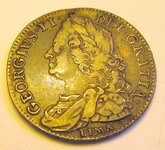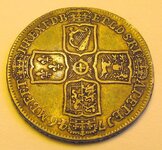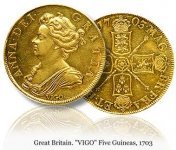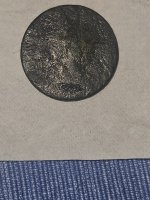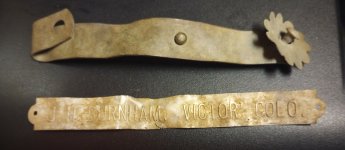divewrecks
Bronze Member
- Sep 7, 2004
- 1,038
- 24
- Detector(s) used
- Minelab Explorer SE (land), Aquapulse AQ1B (sea), Fisher CZ-20 (water, beach), Fisher 1266X (woods)
British crown from my collection....Stan
During the War of the Austrian Succession, Great Britain was the ally of Maria Theresa of Austria, and fought its two greatest maritime rivals, France and Spain. In July 1745, Captains James Talbot and John Morecock, commanding two privateers in the North Atlantic, the Prince Frederick and the Duke, captured two French treasure ships returning from Callao, the port of Lima. Their haul was £800,000 in silver coins and ingots, plus gold and other goods. When they landed at Bristol in October it took 45 wagons to transport the coin and bullion (which weighed over 78 tons) to the Tower Mint. There the silver was used in the production of the so-called 'Lima' coinage of 1746. It was requested that the word 'Lima' be used on the coins to celebrate the exploit. Here LIMA can be seen spelled out under the portrait of King George II (reigned 1727-60)
A letter from a lieutenant on the Prince Frederick was published in Gentleman's Magazine in August 1745:
'The 12th July (which is now the toast here) we took two rich ships... As we shot their masts away, we were obliged to tow them for three weeks, till we got here, in which we had the good fortune never to be disturned by Jack Spaniard or Frenchman. These ships went out four years ago to Peru and Chili and had on board (as by their bills of lading now come to hand) one million sterling in gold and silver coin, besides 800 tons of cocoa, and we are every day discovering more treasure that has been concealed... We have a marquis of France, a governor of Peru, friars in abundance, one of whom threw a gold chalice into the sea of great value that it should not come into our hands.'
During the War of the Austrian Succession, Great Britain was the ally of Maria Theresa of Austria, and fought its two greatest maritime rivals, France and Spain. In July 1745, Captains James Talbot and John Morecock, commanding two privateers in the North Atlantic, the Prince Frederick and the Duke, captured two French treasure ships returning from Callao, the port of Lima. Their haul was £800,000 in silver coins and ingots, plus gold and other goods. When they landed at Bristol in October it took 45 wagons to transport the coin and bullion (which weighed over 78 tons) to the Tower Mint. There the silver was used in the production of the so-called 'Lima' coinage of 1746. It was requested that the word 'Lima' be used on the coins to celebrate the exploit. Here LIMA can be seen spelled out under the portrait of King George II (reigned 1727-60)
A letter from a lieutenant on the Prince Frederick was published in Gentleman's Magazine in August 1745:
'The 12th July (which is now the toast here) we took two rich ships... As we shot their masts away, we were obliged to tow them for three weeks, till we got here, in which we had the good fortune never to be disturned by Jack Spaniard or Frenchman. These ships went out four years ago to Peru and Chili and had on board (as by their bills of lading now come to hand) one million sterling in gold and silver coin, besides 800 tons of cocoa, and we are every day discovering more treasure that has been concealed... We have a marquis of France, a governor of Peru, friars in abundance, one of whom threw a gold chalice into the sea of great value that it should not come into our hands.'


